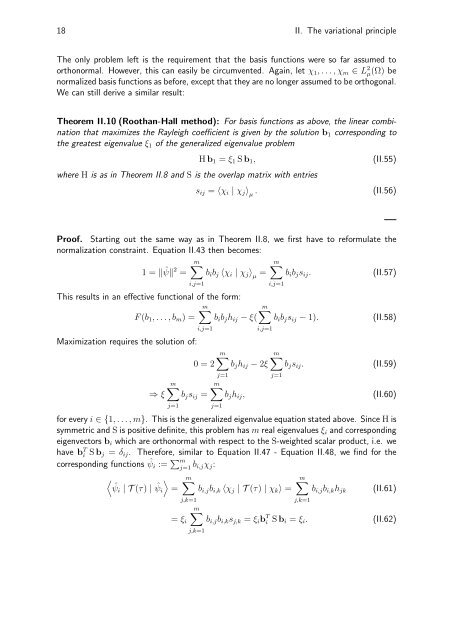Variational Principles in Conformation Dynamics - FU Berlin, FB MI
Variational Principles in Conformation Dynamics - FU Berlin, FB MI
Variational Principles in Conformation Dynamics - FU Berlin, FB MI
- No tags were found...
You also want an ePaper? Increase the reach of your titles
YUMPU automatically turns print PDFs into web optimized ePapers that Google loves.
18 II. The variational pr<strong>in</strong>cipleThe only problem left is the requirement that the basis functions were so far assumed toorthonormal. However, this can easily be circumvented. Aga<strong>in</strong>, let χ 1 ,...,χ m ∈ L 2 µ(Ω) benormalized basis functions as before, except that they are no longer assumed to be orthogonal.We can still derive a similar result:Theorem II.10 (Roothan-Hall method): For basis functions as above, the l<strong>in</strong>ear comb<strong>in</strong>ationthat maximizes the Rayleigh coefficient is given by the solution b 1 correspond<strong>in</strong>g tothe greatest eigenvalue ξ 1 of the generalized eigenvalue problemH b 1 = ξ 1 S b 1 ,where H is as <strong>in</strong> Theorem II.8 and S is the overlap matrix with entriess ij = χ i | χ j µ.(II.55)(II.56)Proof. Start<strong>in</strong>g out the same way as <strong>in</strong> Theorem II.8, wefirsthavetoreformulatethenormalization constra<strong>in</strong>t. Equation II.43 then becomes:1= ˆψmm2 = b i b j χ i | χ j µ= b i b j s ij .(II.57)i,j=1i,j=1i,j=1This results <strong>in</strong> an effective functional of the form:mmF (b 1 ,...,b m )= b i b j h ij − ξ( b i b j s ij − 1).Maximization requires the solution of:⇒ ξ0=2mb j s ij =j=1i,j=1mb j h ij − 2ξj=1mb j h ij ,j=1mb j s ij .j=1(II.58)(II.59)(II.60)for every i ∈{1,...,m}. Thisisthegeneralizedeigenvalueequationstatedabove.S<strong>in</strong>ceH issymmetric and S is positive def<strong>in</strong>ite, this problem has m real eigenvalues ξ i and correspond<strong>in</strong>geigenvectors b i which are orthonormal with respect to the S-weighted scalar product, i.e. wehave b T i S b j = δ ij . Therefore, similar to Equation II.47 - Equation II.48, wef<strong>in</strong>dforthecorrespond<strong>in</strong>g functions ˆψ i := mj=1 b i,jχ j :ˆψi |T(τ) | ˆψ mmi = b i,j b i,k χ j |T(τ) | χ k = b i,j b i,k h jk (II.61)j,k=1j,k=1 m= ξ i b i,j b i,k s j,k = ξ i b T i S b i = ξ i .j,k=1(II.62)









